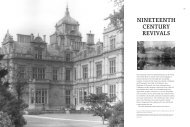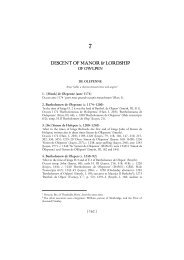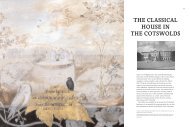Create successful ePaper yourself
Turn your PDF publications into a flip-book with our unique Google optimized e-Paper software.
Chastleton House, Oxfordshire<br />
You approach the archway in front of Chastleton down the<br />
deep lanes of the Oxfordshire Cotswolds, not far from<br />
Morton-on-Marsh, past a pretty dovecote, to find before you,<br />
soaring and solid, five, narrow, brooding gables of brown<br />
ochre stone, with a church set obligingly to one side. It is one<br />
of the most perfect <strong>Jacobean</strong> compositions in the country.<br />
The history of the <strong>manor</strong> begins in 777 with Offa, King of<br />
the Mercians, who made a grant of land here to Evesham<br />
Abbey. It descended to the Catesbys, who owned the <strong>manor</strong><br />
from the late medieval period. The last of them was Robert<br />
Catesby, the charismatic ringleader of the conspirators in the<br />
Gunpowder Plot, killed resisting arrest in 1605. Nothing<br />
remains of the medieval <strong>manor</strong> house which stood on the site.<br />
Chastleton was built anew between 1607 and 1612 for Sir<br />
The entrance with strapwork pediment is set sideways, in the return wall at the lower end of the hall.<br />
The screens’ end of the great hall in its ‘Old English’ arrangement, with contrived clutter, as<br />
photographed by Charles Latham in 1902.<br />
Walter Jones, son of a wool merchant from Witney, who had<br />
prospered at the Bar and was MP for Worcester. Though he<br />
had risen in status from trade to gentry, and proudly traced<br />
his descent from Priam of Troy, his descendants grew poorer<br />
and poorer over the following centuries, so the history of<br />
Chastleton has been uneventful and its fabric preserved<br />
virtually as he left it when he died in 1632. It makes its mark<br />
on history only once, for the codification of the rules of<br />
croquet, in 1868.<br />
Sir Walter Jones’s grandson, Arthur, was known as ‘the<br />
Cavalier’, as he supported the King’s Royalists during the Civil<br />
War and suffered fines under the Commonwealth, after he had<br />
escaped from the battle of Worcester. The Joneses continued<br />
to suffer as High Tory Jacobites in the eighteenth century.<br />
Joneses were succeeded in 1828 by the Whitmores of<br />
Dudmaston in Shropshire. In living memory the descent<br />
moved sideways again to Alan Clutton-Brock, sometime Art<br />
85






